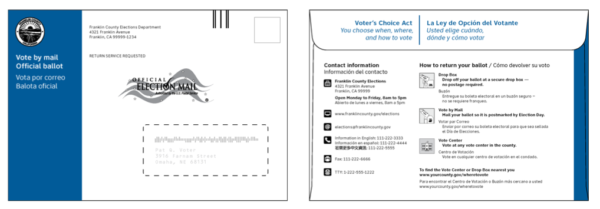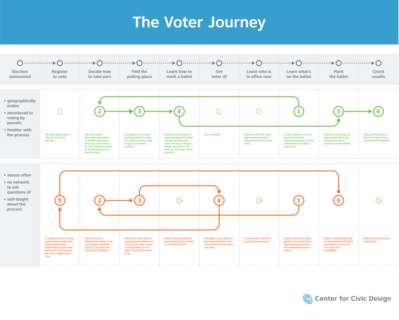Catalyzing change across the voter experience: Center for Civic Design 2017
2017 showed us that we are uniquely positioned to help election departments improve their performance. We realized that the marathon of sprints we’ve been running – because improving the voter experience comes through small, incremental changes over time – was working. Our work has influenced hundreds of election officials over the years, and touched millions of voters in small but important ways.
The projects I have been involved on with you and the CCD team have been some of the most meaningful in my career.
– Jennifer Morrell, Deputy of Elections & Recording, Arapahoe Co.
Our vision: Ensuring voter intent, by design. Voters can exercise their franchise privately, independently, securely, effectively, easily, and confidently.
To reach this vision, we work with government teams to:
- Develop their skills and capacity for delivering the best possible voter experience
- Do this work without our direct assistance
- Make user-centered design a focus of the department’s culture
We have started to define competencies to measure the progress of the teams we work with to determine how close they are to these goals. Our preliminary model is outlined in the section on Impact.
Current and upcoming projects for 2018
Our projects cover our 4 program areas: Election design, election administration, informed voters, and voting systems.
Election design and election administration
Vote-by-Mail. Our work in support of California’s SB450 Voter’s Choice Act (VCA) makes voter-friendly designs for vote-by-mail materials a top priority. We worked closely with the Secretary of State’s office, county election administrators, print and mailing vendors, and the USPS to develop useful, legal templates that are easy to implement and easy for voters to use. There is interest in using the California designs to create a national model. We are in search of funding to work on that.

Outgoing vote-by-mail envelopers for California.
The envelope design features a color bar on the front to identify different types of envelopes. The back includes contacts for the election office and how to return the ballot.
Vote Center Support Materials. Also in support of VCA, we’re rethinking how documentation, checklists, and forms get used in polling places. Building on past research and observations in dozens of polling places over the years, we developed role- and task-based checklists, visual maps for setup, and a “survival guide” of flashcards for troubleshooting. We are working toward pilots in California and elsewhere for statewide primaries in spring and summer of 2018.
June 2017-May 2018, Funded by the James Irvine Foundation
Everyone over here was very impressed with these materials, and we’d be pleased to use the templates for our SB450 training material. The clean look, easy organization, and ability to quickly get information were all elements we were pleased with.
—Travis Dunn, San Mateo County
Virginia Department of Elections. As ELECT’s design team, we lead state officials and general registrars through a new collaborative process to modernize forms and notices used in polling places, ballot standards, recount procedures, and so on. Our goal is to build ELECT’s internal capacity as we work with them, so they can continue to improve the usability and accessibility of elections on their own.

Virginia’s Pocket Guide for Voters is being adapted to be a tool on ElectionTools.org. It has 8 pages, printed on a single sheet, that fold up into a small brochure.
Informed voters
Trust Project. Our Informed Voter study leading up to the 2016 elections revealed how difficult it is for voters to separate signal from noise in elections information. Working with Democracy Fund grantee Sally Lehrman, we are designing public workshops to raise awareness of the Trust Indicators and media best practices. We conducted the first workshop in San Jose in December 2017. We believe that there are ways to apply the Trust Indicators in voter information and education to help election administrators deliver authoritative, trustworthy information to the public.
Voting systems
VVSG 2.0. Our work on the next version of the Voluntary Voting System Guidelines has helped set the standard for the standards. In our work, we support the National Institute of Standards and Technology (NIST) voting team and public working groups as they draft human factors requirements and editing the entire requirements document for plain language
Ranked Choice Voting. We continue our work with FairVote on best practices for ranked choice ballot design, voter education, and display of results for single and multi-winner contests. Our report is now hosted at rankedhcoicevoting.org. We hope this will help election officials in jurisdictions considering RCV. As an example, best practices were featured at a symposium in Denver in December 2017.
The [Center for Civic Design] study is fantastic. It really lays the groundwork for RCV reforms to be made in a thoughtful way.
—Linda Templin – RCV for Colorado
Election administration
Automatic Voter Registration. When Oregon passed its automatic voter registration law and implemented at the beginning of 2017, it started a bipartisan snowball rolling across the country. We have worked or consulted on every AVR implementation so far.
AVR presents a mental shift for voters, technical challenges for state government IT, and coordination and collaboration across state agencies that are unaccustomed to working together. Our role is to ensure that the implementation works well for the public. This means bridging connections among government officials, their vendors, and outside advocates. It also means testing paper forms, web forms, paper and digital notices and messages with government customers.
In 2017, we worked with Oregon, Colorado, California, Virginia, Alaska, and Rhode Island on their voter registration implementations. This year, we are gearing up to work with Pennsylvania, Connecticut, Illinois, and several other states on paper voter registration, online voter registration, NVRA compliance, or AVR.
We’re already seeing patterns in how state services work. By documenting the patterns, we plan to develop tools, checklists, and visual representations that will help us generate best practices for other states to manage implementation, themselves.
Center for Civic Design is particularly experienced and skilled at working through the types of nuanced and detailed questions agencies ask.
—Project partner
Meeting new priorities
There are two areas of elections where there is a growing need for good design: language access and election integrity and security. We are seeking funding to support this work, adding these considerations to all of our projects.
Language Access. Our first work in this area resulted in a white paper and a presentation of our analysis of the design issues for language access at the EAC Language Summit.
We have started to do more testing in other languages to meet the needs of jurisdictions. What we have learned from this work about people with low English proficiency has changed how we design everything from vote-by-mail envelopes to opt-outs for automatic voter registration. We believe the requirements for language access will only grow, and that good design guidance for creating useful and usable bilingual materials will be even more important.
Election integrity and security. As election departments put more services online and transform more of the work in the polling place from paper to digital, the security landscape changes. Based on our earlier work funded by the National Science Foundation and NIST, we know that there are important implications for the design of electronic poll books, ballot issuing systems, voter registration databases, online voter registration, and other software for election workers. We hope to work on best practices for secure—but also usable and accessible—election systems and processes.
Communicating our work
We celebrated our 4th anniversary with a communications splash in the middle of September that included special editions of our newsletter, Civic Designing, and tweet storms of Field Guides, projects, and showcases on Twitter. See all of our media and reports from 2017.
The voter journey
In 2017, we created a visualization of the voter experience in the United States. It is based on interviews and tests with close to 1,000 voters, poll workers, and election officials. It illustrates the burdens voters face in taking part in elections.
It’s a tool for shared understanding. It is also a way for us to explore what we know and where the gaps are in our understanding of the voter experience. We’re confident of our findings in some areas. But there is still much to learn about the specific burdens that people in underserved districts experience, issues for people with low English proficiency, and the best ways to get information about elections to people who need it.

The voter journey maps the many paths from intent to voting.
Impact
Our projects continue to be well received, with opportunities to grow beyond the boundaries of the initial scope.
The best part was hearing from a number of jurisdictions, unsolicited, about how they had used our work and what a difference it has made for their teams.
Applying [CCD’s] usability principles to our MyVote.wi.gov redesign was a game changer for us in Wisconsin! It transformed our approach to all agency IT projects, voter outreach, and even how we approach challenges as a team. Our team’s success with usability is one of my very favorite things to talk about.
– Meagan Wolfe, Assistant Administrator, Wisconsin Election Commission
Jurisdictions we have touched
It’s hard to know all the places our work is touching. Jurisdictions often don’t report back. In some cases, they may not even be aware of where the tools came from. We’re okay with that. We’re happy that they’re using them. Through them we are helping create a better voter experience.
In 2017, we worked directly with: California, Arizona, Colorado, Pennsylvania, Connecticut, Maryland, Virginia, and Rhode Island.
We also connected with Canada through the government’s School of Public Service and Ontario’s provincial government, and Scottish Government, where we gave lectures or led discussion sessions about design in government.
Since 2013, we’ve distributed over 2,000 sets of Field Guides, taught workshops or given talks, written articles for our own web site, and expanded our newsletter mailing list from a few hundred subscribers to about 1600. Our reach extends far beyond the jurisdictions we work with directly.
We have also distributed Field Guides and other tools at IACREAOT, NCSL, and NASED over the years, so we know that there are Field Guides in every state. Not counting states where individual election offices have heard our presentations or received Field Guides, we have seen evidence of our work, based on seeing our guidelines or tools, in at least 26 states.
And we see evidence out in the wild. For example, states like Hawaii and Arizona have used our voter guide templates as inspiration for their own voter guides or documents like poll worker and candidate manuals.
We know that jurisdictions pick up our tools and templates from civicdesign.org and ElectionTools.org. Some counties, such as Marshall County, Kansas, worked with the Center for Technology and Civic Life (CTCL) to implement CTCL’s website template using our information architecture.
I really can’t thank you enough! You and the team at the Center for Civic Design and all the research and case studies have been instrumental to provide guidance to the administration on how to redesign our guides and materials as well as the language that we need to use to communicate easily the voting process.
– Sue Bohorquez, Rhode Island Department of State
Organizational growth
At the end of 2017, we welcomed Colin MacArthur as the newest member of the team. As of this report, we have 4 people on staff, with 6 part-time contractors who are experts working on specific projects. Our design agency partner, Oxide Design Co., continues to provide visual design services.
We’ve formed an advisory committee as part of increasing the formality of the governance. We are so pleased and honored that three exceptional individuals have accepted our invitation.
- Tammy Patrick, Senior Advisor at Democracy Fund
- Joseph Lorenzo Hall, Chief Technologist at Center for Democracy and Technology
- Jennifer Morrell, Deputy of Elections and Recording, Arapahoe County, CO

